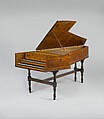On loan to The Met The Met accepts temporary loans of art both for short-term exhibitions and for long-term display in its galleries.
Harpsichord
Jacob Kirkman British
This is the earliest known example of a harpsichord by the renowned Jacob Kirkman of London. Kirkman (anglicized form of Kirchmann) was a Swiss Alsatian who immigrated to England in the early 1730s and found employment with the harpsichord maker Hermann Tabel. After Tabel's death in 1738, Kirkman married his widow and took over his master's workshop including the materials and stock of harpsichords. Jacob later formed a partnership with his nephew Abraham, who later would take his own son Joseph into the workshop. The Kirkman firm was one of the most prolific builders of keyboard instruments in England during the eighteenth century. In addition to harpsichords, the Kirkmans would also build pianos. The company built its last harpsichord in 1809.
This exterior case of this instrument is veneered with cross-banded burr walnut and lighter wood stringing. The hardware including hinges, stop knobs, and lid hooks, are made from brass. The interior of the case and keywell have a reverse color scheme with walnut decorative marquetry on a lighter wood background. The instrument has two manuals with ivory topped naturals and ebony accidentals. The lower keyboard has two eight foot stops and a single four foot stop. The upper keyboard has one four foot set of strings and a lute stop. A "dog-leg" coupler allows the upper keyboard to be activated and sound when the lower manual is played.
According to Charles Mould and Elizabeth Wells, the instrument was used at a program at the Oxford University Musical Club on November 25th, 1890. It was listed as being performed by the musicians and musicologist A. J. Hipkins. It was lent to the event by Mr. T. W. Taphouse.
Due to rights restrictions, this image cannot be enlarged, viewed at full screen, or downloaded.
This artwork is meant to be viewed from right to left. Scroll left to view more.




